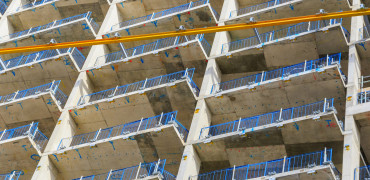Well, well, well … Are you sitting comfortably?
Given the state of building services in many of our buildings, you could well be feeling too hot, or too cold – or that you’re sitting in a draught. You might even still have the lingering ‘office cold’.
Comfort is important to human beings, especially in buildings where we spend 90% of our time.
The issue of ‘wellness’ isn’t new, but it now has an increasing number of advocates in the world of building design.
And building services such as heating, ventilation, cooling and lighting all play a central role in providing space that is not just functional but also healthy, productive and perhaps even enjoyable.
There is certainly a market for occupant well being here
Being healthy
Let’s take a look at health first, since we would all like to assume that the place where we work isn’t actually damaging our physical well being.
The tightly closed, poorly ventilated offices of the past gave rise to ‘sick building syndrome’, and that hasn’t gone away.
Air tightness is great for energy efficiency, but care is needed to ensure that occupants aren’t left in stale, unfiltered air for 8 hours a day.
However, as with all issues of building design, things aren’t that simple. Our outdoor air isn’t always that good.
In fact, the UK government is facing legal action from the EU because air quality in cities like London is so poor.
Safe Havens
The Building Engineering Services Association (BESA) is calling for buildings to be ‘Safe Havens’ where correctly filtered air and well-maintained building services provide clean, healthy air for occupants.
And if you think that sounds a bit far-fetched, consider the recent news from heavily-polluted Chinese cities such as Zhangjiagang where a restaurant was caught charging customers a clean-air fee after it installed an air filtering system.
And in Shanghai the luxury Cordis hotel is using it’s highly-filtered air as a unique selling point – screens in guest rooms show how much cleaner the air inside is than the smog outside.
Well being
There is certainly a market for occupant well being here.
The International Well Building Institute is leading a global movement to ‘transform our buildings and communities in ways that help people thrive.’
BREEAM has been working with WELL to incorporate it’s measures of ‘well being’ in buildings into its system for assessing other areas such as energy use and sustainability.
Of course, the real driver that will decide whether we are focusing on well being as much as energy efficiency will be financial value.
Like that restaurant in China, can London’s office landlords put a value on measurable well being in their buildings?
It’s about you and MEES
The cost of achieving measurably ‘healthier’ buildings would include, for example, upgrades to ventilation and air conditioning – but other legislation such as MEES is already making these options more attractive.
If they can be seen to increase well being too, then that’s all to the good as far as those making the investment are concerned.
There are anecdotal links between better offices and higher productivity. Staff work better, take less sick days and are more likely to stay with the business.
A growing number of studies are taking place. A 2017 research project at Harvard’s Centre for Health and the Global Environment found occupants of high-performing green buildings had higher cognitive function, fewer symptoms of sickness and better sleep quality.
Biophilic
Here in the UK, BRE is looking at the ‘biophilic office’ – how bringing interior environments closer to (pleasant) exterior environments makes occupants happier, healthier and more productive. It’s a long-term study and outputs aren’t expected until late 2019.
But for building services designers and installers, the issue of wellbeing is an important one.
Their work may look as though it revolves around kit and installation methods, but in fact it’s all about people and how they feel indoors.
A greater focus on occupants will definitely require more attention to high-quality building services.
Karen Fletcher is editor of Modern Building Services.



